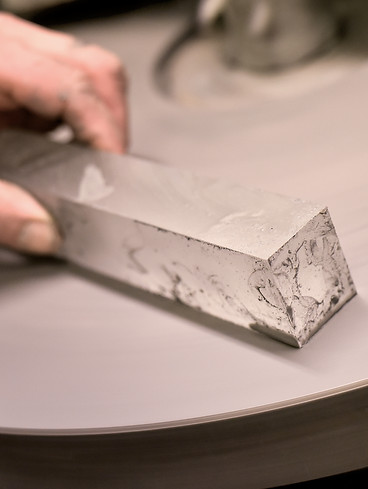TECHNIQUES
Innovative approach to traditional crafts of glass making is refreshing and exciting at the same time. For only the craft that develops and improves over time can keep pace with the fast changing trends.

FUSING & SLUMPING
Glass of different colours and shapes is fused together in the furnace at a temperature of approximately 840 °C. It is possible to use various coloured glass powders, crystal chips, sticks or other semi-products that create required decoration through the process of fusing. Fusing is commonly used to add some texture or pattern that can either melt into the surface of the glass sheet or create a 3D effect on the top.
Glass slumping is a technology where glass is being slumped or curved into special ceramic or stainless steel mould at temperature of 700 °C.
In our fusing & slumping studio we can proceed up to 12 square metres at the time. Due to our year of experiences on bespoke large scale projects we can meet even the most unique demands for extraordinary interiors and architectual solutions.
If required the final product may be treated with a protective varnish to ensure extra safety.
STAINED GLASS & TIFFANY
The history of stained glass runs back to ancient Rome, when pieces of colored glass were assembled into patterned window frames. In Europe, the art of stained glass reached its height between 1150 and 1500, when magnificent windows were created for great cathedrals.
A stained-glass image is created by arranging the different pieces of colored glass over the design drawn on a piece of board in 1:1 scale. If fine details such as shadows, outlines, surface patterns are required, the artist then emloys other glass refining techniques such as painting, cutting, sandblastig, fusing etc. To assemble the glass panel, pieces of colored and painted glass are laid out on the design board, with the edges of each piece fitted into H-shaped strips of lead (cames). These cames are soldered to one another so that the panel is secure. When a panel is completed, putty is inserted between the glass and the lead cames for waterproofing. The entire composition is then stabilized with an iron frame (armature) and mounted in the window, wall or in a part of a furniture.
Our stained-glass studio focuses on the projects in flat glass made by the traditional stained-glass technique as well as on the 3D sculptural and lighting glass objects using a tiffany technique. We are also highly appreciated for re-creating historical glass windows for sacral buildings with a period patina while delicately applying insulating and safety solutions.


ENGRAVING
Glass engraving is a refining technique for creating very delicate decoration and ornamental patterns using grinding wheels and agents both bound and free. It can be seen as a parallel to wood carving. It excels where the great detail of fine cuts, ornaments, floral and figural motifs, portraits, landscape and town vistas and so on is designed. It works both on crystal clear or coloured glass, both in positive or negative relief. This technique was already known in Mesopotamia and Ancient Rome, mainly as a glyptic technique. Its continuous tradition in the Czech Republic goes all the way to the beginning of 17th century and back then it acquired an outstanding quality that has been maintained ever since.
Apart from the classical use of engraving, we welcome bespoke projects that allow us to apply this unique technique in the modern context that involves exciting innovations such as incorporated lighting systems and architectual solutions.
GLASS CUTTING
Glass cutting is a process of modelling the blocks of glass by removing required segments of a glass mass with a free bound grinding agent. This technique is fairly modern in the course of the glass refining history, however it spread very quickly and has become fairly popular. For its nearly endless possibilities of shaping, modelling and cutting, it is loved by the glass artists around the world who use it to turn their glass fantasies and art invention into unique 3D glass objects.


GLASS PAINTING
Glass painting technique requires exceptional craftsmanship, perfect knowledge of the glass technology and chemical processes happening in the glass.
Special glass paints are used for painting on glass that are made of lead-orthoboric glass with colouring ingredients melting at low temperatures. They are grinded into a very fine powder which is mixed with turpentine and other binders before the actual application. The colours are fired in an electrical furnace at temperature of about 560 °C.
Apart from the glass paints we work with formulas of precious metals (gold, platinum lustres and our 24 carat „dry gold“). The precious metals are dissolved in chemical solution. After the application they are fired in decorating kiln at temperature of 560 °C.
In our glass painting studio we focus both on the traditional projects such as historical replicas or renovation of the painted stained glass as well as on the very contemporary design glass pieces. We continuously develop new painting solutions for the flat and fused glass that is widely used as a part of the bespoke interiors and modern architecture.
WOVEN CRYSTAL TECHNIQUE
By this technique, crystal pearls and beads of different diameter are woven together on the stainless steel or perspex wires in repetitive steps to achieve a desired pattern. We use this imposing style mostly for creating large luxurious lighting scultpures and bespoke interior objects for commerical spaces and high-end private residences.

